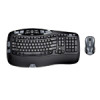Logitech Desktop Wave Making of Wave - Page 6
Reinventing Assembly Tools, New Packaging - pictures
 |
View all Logitech Desktop Wave manuals
Add to My Manuals
Save this manual to your list of manuals |
Page 6 highlights
Creating Comfort: The Making of the Logitech Comfort Wave Design - Page 6 But to the surprise of everybody, however, the most comprehensive design approach - the curve + wave + palm rest combination - turned out to be the favorite. The Logitech Comfort Wave Design was chosen and named. Logitech would be the first to combine a wave-shaped key frame, a U-shaped curve and a padded palm rest. All the research and development - taking the keyboard design from concept to a viable model - was completed. It was time for the development team to start working with their colleagues in Asia to determine how to manufacture the Wave keyboards on a large scale. Reinventing Assembly Tools Traditionally, straight keyboards are assembled in several stages, which include creating the keys, the membranes and the housing. Because of the wave-shaped key frame, Logitech completely redesigned nearly every element of the assembly process, including key molding, rubber dome production, printing and testing. Typically, keyboards have approximately a dozen different types of keys. There is one tool that creates all of the key caps. The plastic is injected and each key cap is molded by the tool in one shot. These are then automatically inserted into the keyboard's topcase. For the Wave keyboards, Logitech's industrial design team, located in Taiwan, created an entirely different approach that involves seven tools with several key cap sizes for each tool. Then, Logitech's Suzhou, China-based manufacturing team went to work. Once molded, these key caps are collected into seven different bags and manually inserted on the product lines by operators, one by one. But the key stamping process wasn't the only element that caused Logitech to alter the manufacturing process. Like most keyboards, the Wave keyboard uses a rubber dome underneath the keys to send signals from the keyboard to the computer. Unlike the flat shape of traditional rubber dome membranes, the Wave rubber dome had to be fitted to conform to the shape of the Wave. That meant, the rubber dome had to be redesigned on three dimensions instead of just two. Finally, the manufacturing-testing process had to be redesigned to accommodate the wave key frame. New Packaging Manufacturing wasn't the only group within Logitech that had to make substantial changes to accommodate the Wave keyboard. After assessing existing Logitech keyboard-packaging designs, the California-based packaging team realized that the Wave keyboard demanded a new package altogether. One that would allow shoppers to get a feel for the Wave, rather than make a purchase decision based on a picture on the box. To accomplish their goals, the packaging team created a specially designed, contouredThermoform plastic shaped to conform to the Wave key frame so people can experience










